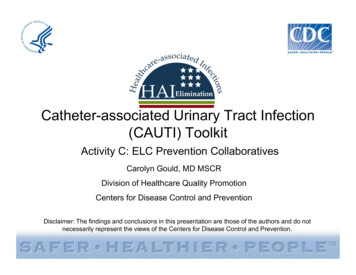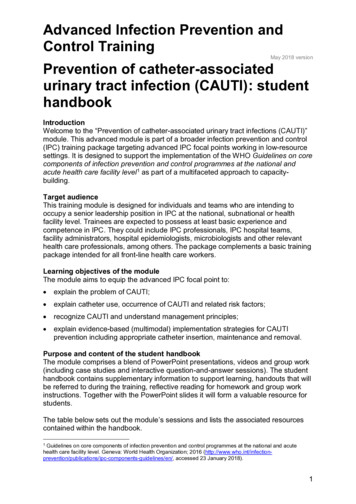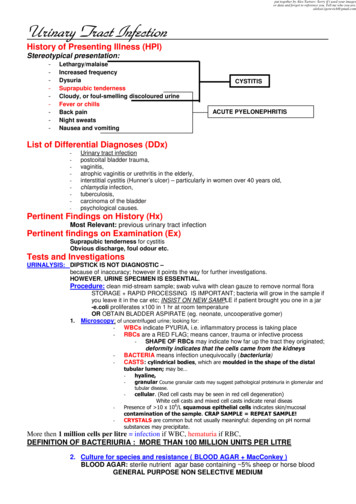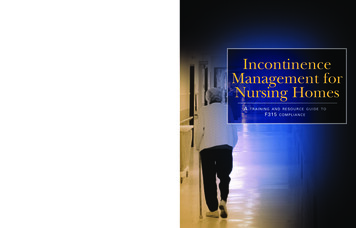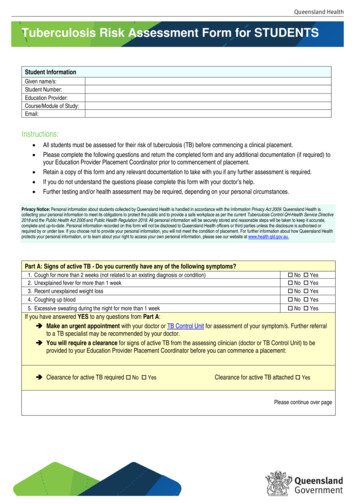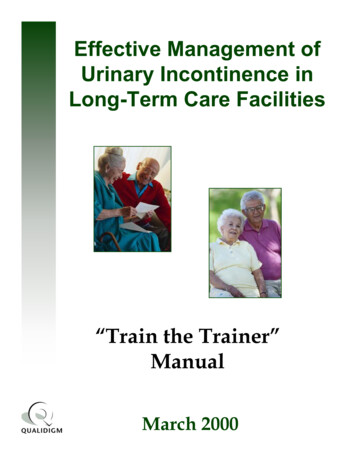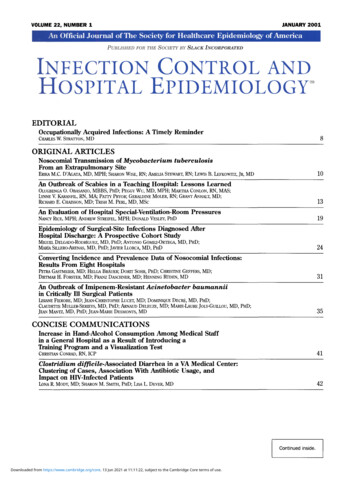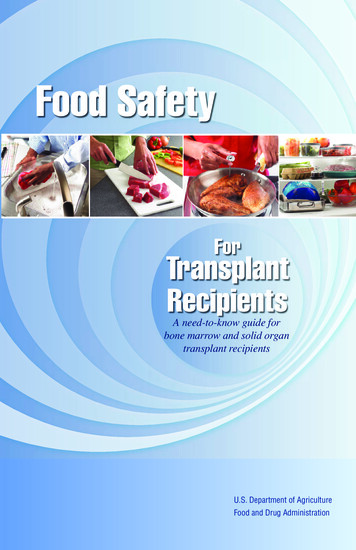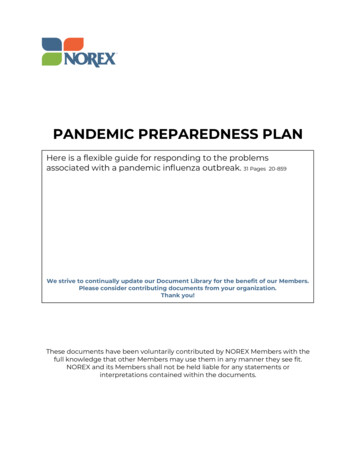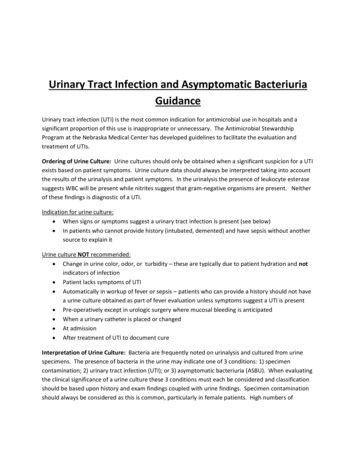
Transcription
Urinary Tract Infection and Asymptomatic BacteriuriaGuidanceUrinary tract infection (UTI) is the most common indication for antimicrobial use in hospitals and asignificant proportion of this use is inappropriate or unnecessary. The Antimicrobial StewardshipProgram at the Nebraska Medical Center has developed guidelines to facilitate the evaluation andtreatment of UTIs.Ordering of Urine Culture: Urine cultures should only be obtained when a significant suspicion for a UTIexists based on patient symptoms. Urine culture data should always be interpreted taking into accountthe results of the urinalysis and patient symptoms. In the urinalysis the presence of leukocyte esterasesuggests WBC will be present while nitrites suggest that gram-negative organisms are present. Neitherof these findings is diagnostic of a UTI.Indication for urine culture: When signs or symptoms suggest a urinary tract infection is present (see below) In patients who cannot provide history (intubated, demented) and have sepsis without anothersource to explain itUrine culture NOT recommended: Change in urine color, odor, or turbidity – these are typically due to patient hydration and notindicators of infection Patient lacks symptoms of UTI Automatically in workup of fever or sepsis – patients who can provide a history should not havea urine culture obtained as part of fever evaluation unless symptoms suggest a UTI is present Pre-operatively except in urologic surgery where mucosal bleeding is anticipated When a urinary catheter is placed or changed At admission After treatment of UTI to document cureInterpretation of Urine Culture: Bacteria are frequently noted on urinalysis and cultured from urinespecimens. The presence of bacteria in the urine may indicate one of 3 conditions: 1) specimencontamination; 2) urinary tract infection (UTI); or 3) asymptomatic bacteriuria (ASBU). When evaluatingthe clinical significance of a urine culture these 3 conditions must each be considered and classificationshould be based upon history and exam findings coupled with urine findings. Specimen contaminationshould always be considered as this is common, particularly in female patients. High numbers of
squamous cells on the urinalysis ( 20) suggests contamination and results of the culture shouldgenerally be ignored.In patients with a positive urine culture, where no contamination exists, clinicians must determine if thepatient is exhibiting symptoms of a UTI. Symptoms typical of a UTI are urinary frequency or urgency,dysuria, new onset hematuria, suprapubic pain, costovertebral tenderness or fever. Patients with aurinary catheter in place may have more vague symptoms such as new onset or worsening fever, chills,pelvic discomfort, acute hematuria and altered mental status with no other identifiable etiology.It is important to recognize that pyuria is not an indication for treatment. Pyuria is the presence of anincreased number of polymorphonuclear leukocytes in the urine (generally 10 WBC/hpf) and isevidence for genitourinary tract inflammation. Pyuria can be seen in patients with catheter use, sexuallytransmitted diseases, renal tuberculosis, interstitial nephritis, or ASBU. The absence of pyuria is a strongindicator that a UTI is not present and is useful in ruling out a UTI.Asymptomatic BacteriuriaPatients with positive urine cultures who lack symptoms of a UTI have the diagnosis of asymptomaticbacteriuria. ASBU is more common in some patient populations and the prevalence increases withadvancing age (Table 1). It is also associated with sexual activity in young women. Patients withimpaired urinary voiding or indwelling urinary devices have a much higher prevalence of ASBU.Table 1: Prevalence of asymptomatic bacteriuria in selected populationsPopulationHealthy, premenopausal womenPregnant womenPostmenopausal women aged 50-70Diabetic patientsWomenMenElderly person in the community ( 70 yrs.)WomenMenElderly person in a long-term care facilityWomenMenPatients with spinal cord injuriesIntermittent catheter useSphincterotomy and condom catheter in placePatients undergoing hemodialysisPatients with indwelling catheter useShort-termLong-termPrevalence, 5015-4023-8957289-23100
Screening for and treating ASBU patients should only occur if the bacteriuria has an associated adverseoutcome (such as development of a symptomatic urinary tract infection, bacteremia, progression tochronic kidney disease, etc.) that can be prevented by antimicrobial therapy. There are only 2 clinicalsituations where these criteria are clearly met. Pregnant women should be screened and treated forASBU, as they have a significantly increased risk of developing pyelonephritis as well as experiencing apremature delivery and delivering a low birth weight infant. Prior to transurethral resection of theprostate (TURP) or any other urologic procedure with a risk of mucosal bleeding, patients should bescreened for bacteriuria, as it has been associated with a major increase in the risk for post-procedurebacteremia and sepsis. Treatment of ASBU in both these situations has been demonstrated to preventthese complications.Unfortunately many patients with ASBU receive treatment which they do not benefit from and in factare likely harmed by. The unnecessary treatment of ASBU can lead to antibiotic resistance, adverse drugeffects, C. difficile infection, and contribute unnecessarily to the costs of medical care. Gandhi andcolleagues described antibiotic use for 3 months on a single medicine ward with 54% (224/414) ofpatients treated with antimicrobials and UTI the most common diagnosis (N 49). Of those who weretreated for a UTI, 32.6% had no symptoms suggestive of a UTI. In another study Cope, et al. analyzed280 catheterized patients at a VA with 58.6% considered to have ASBU. Thirty-two percent of ASBUpatients received treatment (inappropriately) with 3 patients developing a C. difficile infection. Linares,et al. found 26% of 117 patients with ASBU at his institution were treated inappropriately for an averageof 6.6 days and the treatment resulted in 2 cases of C. difficile infection and one case of QTprolongation. They then introduced an electronic reminder which did not decrease the incidence ofinappropriate treatment (still 26%) but decreased duration of therapy to 2.2 days and with no antibioticadverse events noted.Patients at TNMC are not excluded from this inappropriate treatment. An analysis of 68 patients withpositive urine cultures on 2 medical wards at TNMC over 3 months in 2011 revealed that 22 (32.4%)were asymptomatic using a very liberal definition of symptoms. Antimicrobials were inappropriatelyprescribed to 36.4% (8/22) of those with ASBU. This resulted in two patients developing clinicallysignificant diarrhea with one of them being diagnosed with a C. difficile infection.The take home message is that treatment of ASBU is common and results in significant patient harm.Clinicians should be aware of this when making decisions about the treatment of possible UTI.Who to screen and treat for asymptomatic bacteriuria: Pregnant women (at least once in early pregnancy) Patients prior to a urologic procedure for which mucosal bleeding is anticipated (i.e. TURP, etc.) Kidney transplant patients are a group where the data is unclear and no recommendation canbe madeWho not to screen or treat for asymptomatic bacteriuria: Premenopausal, non-pregnant womenDiabetic women
Older persons living in the communityElderly institutionalized residents of long-term care facilitiesSpinal cord-injured patientsPatients with an indwelling urethral catheter (do not treat asymptomatic funguria either)Positive Urine Culture AlgorithmThis algorithm is designed for common clinical situation where the treating clinician is required tointerpret urine culture results 24-48 hours after they were obtained by another provider and the clinicalsituation that prompted the testing is not clear.Positive Urine Culture Definition 5Clean catch specimen with 10cfu/ml of 1 bacterial species*3Catheterized specimen with 10cfu/ml of 1 bacterial species*ContaminationEvaluate the Urinalysis( 20 squamous cells/hpf) Disregard if no symptoms of UTIConsider obtaining new specimen ifsuspicious for UTI exists No Contamination( 20 squamous cells/hpf)*The presence of 3 or more bacterialspecies in the urine suggests the specimenis contaminated and a new specimenshould be obtained if a UTI is suspectedEvaluate for ongoing symptoms of UTIDysuria, frequency, urgency, fever,suprapubic or CVA pain/tenderness,mental status changes/lethargywithout another explanationNo symptomsAsymptomatic bacteriuria Do not treat unlesspregnant or impendingurologic procedure withbleeding anticipated Unclear/Difficult to Determine Use Clinical JudgmentLack of pyuria is strongevidence UTI is absentSymptoms Present UTITreat based on guidelines
Treatment of Urinary Tract Infections in AdultsComplicated vs. Uncomplicated UTIsIf it is determined that a patient has a urinary tract infection based on symptoms, UA, and urine culture(see algorithm below), a decision must be made on how to treat the infection. Multiple factors play arole deciding on the most appropriate therapy choice and duration including: type of UTI (complicatedor uncomplicated), if concern for pyelonephritis exists, patient allergies, location of patient (hospital,community, or long-term care facility), recent history of UTI or antibiotic exposure, previous urinarypathogens isolated, and cost of agent to be prescribed.Patients with UTI can generally be seperated into 2 clinical groups: complicated and uncomplicated. Acomplicated UTI is a UTI in the setting of an underlying condition or factor which increases the risk oftreatment failure. Some of these factors include: Male sexDiabetesPregnancySymptoms 7 days prior to seeking careHospital acquired infectionRenal failureUrinary tract obstructionPresence of an indwelling urethral catheter, stent, nephrostomy tube or urinarydiversionRecent urinary tract instrumentationFunctional or anatomic abnormality of the urinary tractHistory of urinary tract infection in childhoodRenal transplantationImmunosuppressionPut another way episodes of acute cystitis occuring in healthy, premenopausal, nonpregnant womenwith no history suggestive of an urinary tract abnormalities are considered uncomplicated urinary tractinfections and all other UTIs are classified as complicated.In patients with uncomplicated UTIs, E. coli is responsible for 75-95% of infections and empiric therapyshould be directed at this pathogen. E. coli is still the most common pathogen in complicated UTIs, butother pathogens such as Klebsiella, Proteus, and Enterobacter are also noted. Inlcuded below aretreatment guidelines for acute uncomplicated cystitis, complicated UTI, and pyelonephritis based uponlocal susceptibility and the Infectious Diseases Society of America guidelines.
UTI Treatment AlgorithmSuspicion for UTI Evaluate for symptoms of UTINon-specific SymptomsSymptoms Suspicious for UTI(Confusion, malaise without other cause) Obtain urinalysis, re-evaluatesymptoms daily Do not start empiric therapy unlessclinically unstable(Dysuria, frequency, urgency, fever,suprapubic or CVA pain/tenderness) Obtain urinalysis and urine culture Start empiric therapyTherapy OptionsUA 10 WBC/hpf(Base treatment choice on type of UTI,severity of illness, and likelihood ofresistance) Evaluate previous urine culture results Evaluate for signs of pyelonephritisand severe sepsisUA 10 WBC/hpfNot a UTIConsider other diagnosesObtain Urine CulturePositive Urine CultureCath Specimen: 103 cfu/mLClean Catch: 105 cfu/mLOf 1 bacterial speciesNegative Urine CultureCath Specimen: 103 cfu/mLClean Catch: 105 cfu/mLRe-evaluate symptomsSymptoms continueSymptoms have resolved Treat for UTIBase therapy on urineculture results
Treatment of Uncomplicated Cystitis in WomenUncomplicated cystitis is defined by the presence of typical lower urinary tract symptoms (dysuria,frequency, urgency, hematuria) and lack of upper tract sypmtoms (see below) in an otherwise healthypre-menopausal female.Woman with acute uncomplicated cystitis Absence of fever, flank pain or othersuspicion for pyelonephritis Able to take oral medicationConsider alternative diagnosis(such as pyelonephritis orcomplicated UTI) & treataccordinglyNoYesCan one of these first line agentsbe used considering allergyhistory, tolerance, and cost? NoNitrofurantoinmonohydrate/macrocrystals100 mg bid x 5 days( 35)*ORTrimethoprimsulfamethoxazole 160/800mg (one DS tablet) bid x 3days ( 5-10)*ORFosfomycin trometamol 3gsingle dose( 70)** Price without insuranceYesPrescribe a recommended antimicrobialConsider use of one of the following: Fluoroquinolones (ciprofloxacin orlevofloxacin)o Increased risk of C. difficileinfection and resistanceprevalence highOR Beta-lactams (e.g. amoxicillinclavulanate, cephalexin,cefuroxime, cefdinir)o Decreased cure ratescompared to other agents;requires close follow-upo Consider previous urinecultures and local antibiogramwhen selecting therapy
Treatment of Complicated UTIComplicated UTIs are defined above but generally are UTIs which occur in women who haveabnormalities of the urinary tract or immune function which predispose them to treatment failure orUTIs which occur in men. Much less data is available to guide treatment recommendations in thispatient group. The pathogens causing complicated UTIs are more diverse, more drug resistant, andspecific guidelines for this syndrome are not available. The guidance below is primarily directed atoutpatients and inpatients with complicated UTIs should have therapy based on previous culture results,severity of illness, and the local antibiogram.Treatment duration has traditionally been 10-14 days, but recent data from the VA suggested 7 days oftherapy for men with complicated UTIs was adequate. Based on these data treatment durations of 7-10days are generally recommended, although shorter durations of fluoroquinolone therapy (5-7 days)have achieved excellent cure rates.Complicated Cystitis:1. Ciprofloxacin 500mg PO bid or levofloxacin 250mg PO qday2. Trimethoprim-sulfamethoxazole 160/800 mg (one DS tablet) bidAlternatives with less data or less activity:1. Oral beta-lactams (oral 2nd and 3rd generation cephalosporins are more active based upon ourantibiogram than agents such as cephalexin or amoxicillin/clavulanate)2. Nitrofurantoin 100 mg PO BID (not recommended in patients with concern for pyelonephritis orthose with poor renal function)
Treatment of PyelonephritisThe presence of pyelonephritis is suggested by the presence of upper urinary tract symptoms such asfever, CVA tenderness, nausea, vomiting, and signs of severe sepsis. Patients with pyelonephritis shouldbe evaluated for hospitalization and a decision made on the site of care based on severity of illness andhost factors (ability to take oral agents, allergies, history of antimicrobial resistance, home support, etc.).An important factor to consider when choosing therapy for pyelonephritis is the likelihood of bacterialresistance to common therapies. Numerous studies have been published evaluating risk factors forresistance in UTI pathogens and common risk factors associated with the isolation of multi-drugresistant (MDR) pathogens have generally included: Residence in a long-term care facilityRecent receipt of broad spectrum antibiotics (including fluoroquinolones)History of recurrent UTIsHistory of having an MDR urinary pathogenNosocomial UTIThese risk factors particularly identify patients at risk for resistance to fluoroquinolones and/or 3rdgeneration cephalosporins (typically via production of an extended-spectrum beta-lactamase (ESBL)). Itshould be noted that baseline E. coli resistance to quinolones at TNMC is roughly 20% while resistanceto 3rd-generation cephalosporins such as ceftriaxone is much less (around 5%).Non-hospitalized/early pyelonephritis:1. Oral ciprofloxacin 500 mg bid OR Levofloxacin 750mg daily2. Oral trimethoprim-sulfamethoxazole (TMP-SMX) 160/800 mg [1 double-strength tab] twice dailyDue to high resistance rates in E. coli all patients should receive an initial one-time intravenous dose ofceftriaxone 1 gram or a consolidated 24 hour dose of an aminoglycoside (i.e. gentamicin 5 mg/kg)Patients requiring hospitalization: Fluoroquinolones and TMP/SMX are not recommended forpatients admitted with pyelonephritis due to high rates of resistance ( 20%). When susceptibilitiesresults return patients may be de-escalated to a FQ or TMP/SMX if they are susceptible.No risk factors for multi-drug resistant organisms:1. Ceftriaxone 1g IV q24h (2g if 80kg)2. Severe beta-lactam allergy: Aztreonam 2g IV q8hRisk factors for multi-drug resistant organisms:1. Piperacillin/tazobactam 4.5g IV q8h, infused over 4 hours OR2. Ertapenem 1g IV q24h OR3. Cefepime 1g q6h4. Severe beta-lactam allergy: Aztreonam 2g IV q8h PLUS vancomycin per pharmacy consult
Patients with severe sepsis or septic shock consider the addition of:1. Gentamicin 7 mg/kg IV q24h (extended-interval dosing)2. Vancomycin per pharmacy consultThe addition of other antimicrobials (gentamicin, vancomycin) should be based upon severity of illnessand likelihood of resistance.Treatment Duration: Traditionally pyelonephritis has been treated for 10-14 days but studies havedemonstrated that patients treated with fluoroquinolones for 5-7 days had similar cure rates to thosetreated for 14 days. When patients are started on beta-lactams and transitioned to fluoroquinolones atreatment course of 5-7 days of the FQ is likely adequate.Table 1: Treatment Duration for Pyelonephritis and Complicated UTIAgentDuration of TherapyFluoroquinolones (ciprofloxacin, levofloxacin) 5-7 daysBeta-lactams10-14 daysTMP/SMX14 days
Catheter-Associated Urinary Tract Infections (CA-UTIs)Diagnosis: In patients with indwelling urethral or suprapubic catheters or those who receiveintermittent catheterization, UTIs typically presents without the usual lower urinary tract symptoms ofdysuria, frequency, or urgency. Despite this, CA-UTI is defined by the presence of both symptoms and apositive urine culture: Symptoms and/or signs compatible with UTI may include: new onset or worsening of fever,rigors, altered mental status, malaise, or lethargy with no other identified cause; flank pain;costovertebral angle tenderness; new onset hematuria; or pelvic/suprapubic discomforto Symptoms in patients with spinal cord injury may include increased spasticity,autonomic dysreflexia, or a sense of unease as well3 10 colony-forming units (cfu)/mL of 1 bacterial species in a single catheter urine specimenor in a midstream voided urine specimen from a patient whose urethral, suprapubic, or condomcatheter has been removed within the previous 48 hours is considered a positive urine culturePyuria and bacteriuria are very common in the presence of a urinary catheter are not an indication fortreatment in patients who lack symptoms of a UTI.Evaluation and Treatment (see algorithm below): Always obtain a urine culture prior to initiation of antimicrobial therapy.o If the indwelling catheter has been in place for 2 weeks at the onset of CA-UTI andis still indicated, replace the catheter and obtain urine culture from new catheter.o If urinary catheter no longer indicated, remove catheter and obtain culture from avoided midstream urine specimen. Patients who have a CA-UTI and have had their catheter longer than 14 days should havethe catheter exchanged Choose therapy based on severity of illness and risk factors for resistant pathogens Treat with antimicrobials for 7-14 days depending on severity and clinical responseo Prompt resolution of symptoms 7 days Levofloxacin x 5 days may be considered in patients who are not severely illo Delayed response or severely ill 10-14 daysTable 2: Treatment Options for CA-UTIMild/moderate illness – treatas per complicated cystitisguidanceSeverely ill – treat as per MDRrisk pyelonephritis guidanceFirst Line TherapyLevofloxacin 250mg PO qday ORTMP/SMX 1 DS Tab BIDPiperacillin/tazobactam 4.5g IVq8h over 4 hours ORErtapenem 1g IV qday ORCefepime 1g q6hAlternative TherapyOral 2 and 3rd-gen cephalosporinsCeftriaxone 1g IV qday (if previouspathogen resistant to FQ orhospitalized 5 days)Aztreonam (beta-lactam allergy)Aztreonam 2g IV q8h vancomycinpharmacy to dose (beta-lactamallergy)nd
TNMC Urinary AntibiogramUrine culture data from 6/2012-6/2013 was utilized to develop the following charts demonstrating TheNebraska Medical Center susceptibility rates of uropathogens. This data should serve as a guide forinitial empiric antimicrobial therapy for pyelonephritis and complicated UTIs and also as guidance toevaluate the activity of specific agents when early identification data is available (i.e. lactose-fermentingGram-negative rods or Enterococci). As per above, once susceptibility results are available,antimicrobials should be tailored appropriately.Gram-Negative Organisms Isolated from the UrineE. coli(N 2014)Klebsiellapneumoniae(N 405)Proteusmirabilis(N 184)Pseudomonasaeruginosa(N 134)Enteric (LactoseFermenting)Gram-neg rodsNon-lactoseFermentingGram-neg rods(oxidase .422.699.50.599.589.977.4% efepimeCefuroxime cillin/tazobactam97.8Tobramycin92.9TMP/SMX (Bactrim)77.8XX not generally susceptible
Gram-Positive Organisms Isolated from the UrineEnterococcusfaecalis (N 292)Ampicillin100OxacillinXXTMP/SMX 9.3Nitrofurantoin99Vancomycin98.3XX not generally susceptible% SusceptibleEnterococcusfaecium (N 60)8.1XXXX61.46.698.414.821.3Enterococcus(species aureus (N 82)XX54.910010047.6100100100Authors: Andrea Green Hines MD, Mark E Rupp MD, and Trevor C Van Schooneveld MDReviewed and Approved by Antimicrobial Stewardship Subcommittee of Pharmacy and TherapeuticsCommittee of the Nebraska Medical Center, July 2014References:1. Centers for Disease Control. Catheter-associated urinary tract infection (CAUTI) event. NHSNPatient Safety Component CAUTIcurrent.pdf. Updated August 2011.Accessed November 4, 2011.2. Gould C, Umscheid C, Agarwal R, Kuntz G, Pegues D, Healthcare Infection Control PracticesAdvisory Committee (HICPAC). Guideline for prevention of catheter-associated urinary tractinfections 2009. 2009final.pdf. AccessedNovember 4, 2011.3. Gupta K, Hooton T, Naber K, Wullt B, Colgan R, Miller L, Moran G, Nicolle L, Raz R, Schaeffer A,Soper D. International Clinical Practice Guidelines for the Treatment of Acute UncomplicatedCystitis and Pyelonephritis in Women: A 2010 Update by the Infectious Diseases Society ofAmerica and the European Society for Microbiology and Infectious Diseases. Clin Infect Dis.2011; 52: e103-120.4. Hooton T, Bradley S, Cardenas D, Colgan R, Geerlings S, Rice J, Saint S, Schaeffer A, Tambayh P,Tenke P, Nicolle L. Infectious Diseases Society of America Guidelines for the diagnosis,prevention, and treatment of catheter-associated urinary tract infections in adults. Clin InfectDis. 2010; 50: 625-663.5. Nicolle L, Bradley S, Colgan R, Rice J, Schaeffer A, Hooton T. Infectious Diseases Society ofAmerica Guidelines for the diagnosis and treatment of asymptomatic bacteriuria in adults. ClinInfect Dis. 2005; 40: 643-654.6. U.S. Preventive Services Task Force. Screening for asymptomatic bacteriuria in adults, evidencefor the U.S. Preventative Services Task Force reaffirmation recommendation statement. AnnIntern Med. 2008; 149: W-20-W-24.
7. Mody L, Juthani-Mehta M. Urinary tract infections in older women. JAMA. 2014;311:844-54.8. Gandhi T, Flanders SA, Markovitz E, et al. Importance of urinary tract infection to antibiotic useamong hospitalized patients. Infect Control Hosp Epidemiol. 2009;30:193-5.9. Cope M, Cevallos ME, Cadle RM, et al. Inappropriate treatment of catheter-associatedasymptomatic bacteriuria in a tertiary care hospital. Clin Infect Dis. 2009;48:1182-8.10. Linares LA, Thornton DJ, Strymish J, et al. Electronic memorandum decreases unnecessaryantimicrobial use for asymptomatic bacteriuria and culture-negative pyuria. Infect Control HospEpidemiol. 2011;32:644-8.11. Drekonja DM, Rector TS, Cutting A, Johnson JR. Urinary tract infection in male veterans:treatment patterns and outcomes. JAMA Intern Med. 2013;173:62-8.
pre-menopausal female. Fosfomycin trometamol 3g . Woman with acute uncomplicated cystitis (such as pyelonephritis or Absence of fever, flank pain or other suspicion for pyelonephritis complicated UTI) & treat Able to take oral medication No Consider alternative dia
